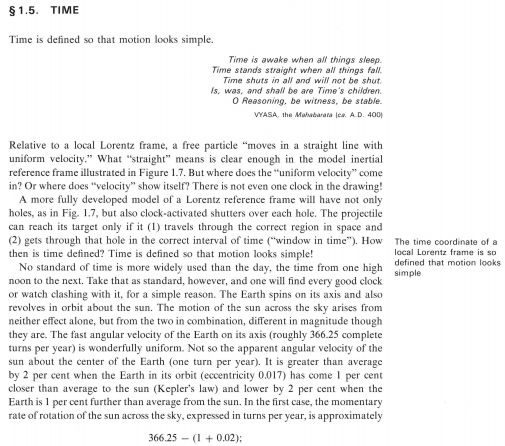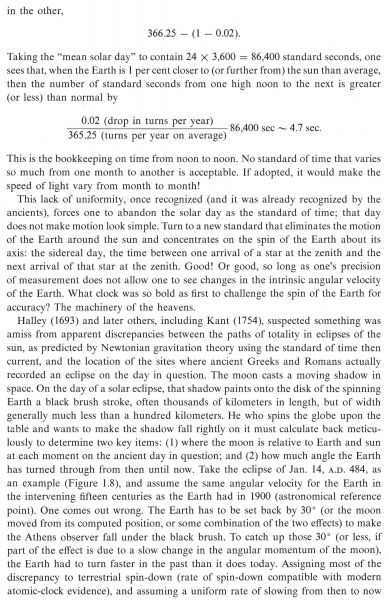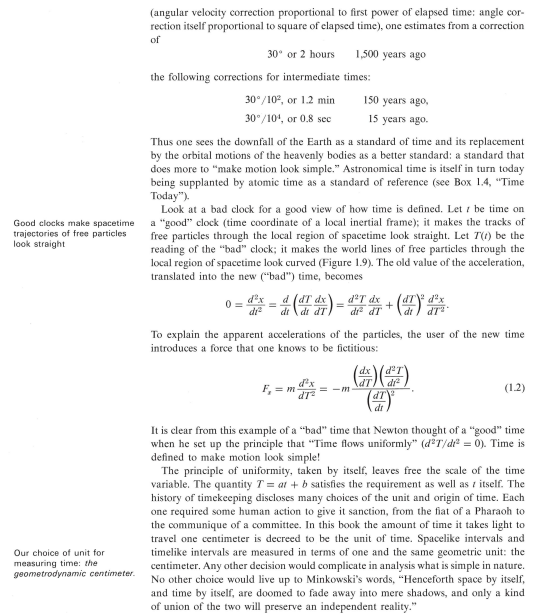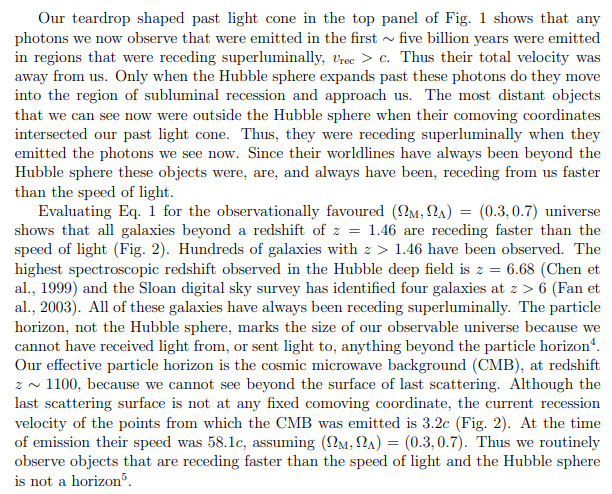-
Posts
5374 -
Joined
-
Days Won
52
Content Type
Profiles
Forums
Events
Everything posted by Genady
-

Why is it so hard to explain time? (What is time?)
Genady replied to chron44's topic in Classical Physics
Here is the explanation of how time is defined, from the Gravitation by Misner, Thorne, and Wheeler: -

Why is it so hard to explain time? (What is time?)
Genady replied to chron44's topic in Classical Physics
There are many scientific formulas for time. For example, \(t= \frac d v\), \(t'=\gamma(t- \frac {vx}{c^2})\), \(d \tau^2=dt^2-ds^2\), etc. -
You did not ask.
-

Proportion of the area covered by circles
Genady replied to Dhamnekar Win,odd's topic in Applied Mathematics
No, not necessarily. For example, if \(r_n= \frac c n\) then \[\lim_{n \to \infty} n \cdot r_n=c\] -
"Why do we use kelvin to measure heat?" We do not.
-

Proportion of the area covered by circles
Genady replied to Dhamnekar Win,odd's topic in Applied Mathematics
Not necessarily. As \(n \rightarrow \infty\), \(r_n \rightarrow 0\). -

How can a big bang expand to an infinite size?
Genady replied to Airbrush's topic in Astronomy and Cosmology
The central postulate of general relativity is that local physics is physics of special relativity. And special relativity does not make any claims about matter. -

Why is it so hard to explain time? (What is time?)
Genady replied to chron44's topic in Classical Physics
Cognitive abilities are not a topic in physics. This post belongs to another forum. -

Proportion of the area covered by circles
Genady replied to Dhamnekar Win,odd's topic in Applied Mathematics
You need to express it as a function of \(n\). -

How can a big bang expand to an infinite size?
Genady replied to Airbrush's topic in Astronomy and Cosmology
It removes the consideration of superluminal expansion from the point you were trying to make. -

How can a big bang expand to an infinite size?
Genady replied to Airbrush's topic in Astronomy and Cosmology
This is a common misconception. In fact, we can and do see light coming to us from sources which recede faster than \(c\). It is so because as the emitted light moves away from its source along the line connecting us to the source, it gets to parts which recede from us slower than the source. Eventually, it gets to parts which recede slower than \(c\). Here is a more detailed description: ([astro-ph/0310808] Expanding Confusion: common misconceptions of cosmological horizons and the superluminal expansion of the Universe (arxiv.org)) -

Proportion of the area covered by circles
Genady replied to Dhamnekar Win,odd's topic in Applied Mathematics
Anyway, n cannot be 2 in these configurations if n is: -

Proportion of the area covered by circles
Genady replied to Dhamnekar Win,odd's topic in Applied Mathematics
Never mind, I got it. Looking at it ... How can you replace \(n\) by \(2\) in \(R_n\), but leave it \(n\) everywhere else in the expression? -

How can a big bang expand to an infinite size?
Genady replied to Airbrush's topic in Astronomy and Cosmology
Yes, this is it. If the light were somehow tied to the 2D surface and went strictly along it, the ship would not disappear. A straight line on the surface of Earth is a great circle. But the light ray does not follow it - it rather follows a straight line in the 3D space. Consider the example of a cylinder again. Imagine that the planet has a cylindrical shape. Unless the ship goes in the direction of the cylinder's axis, it will be disappearing behind the horizon as usual. But we know that the intrinsic curvature of the cylinder is 0. So, the disappearance of the ship over the horizon is a consequence of the extrinsic curvature, i.e., of how the surface is curved in the embedding space. -

How can a big bang expand to an infinite size?
Genady replied to Airbrush's topic in Astronomy and Cosmology
A minor correction here: one measures Δ=(sum-of-the-angles-of-a-triangle)−π . If Δ>0 , i.e., sum of the angles is more then 180o , then the curvature is positive (like a sphere). If Δ<0 , i.e., sum of the angles is less then 180o , then the curvature is negative (like a saddle). You would not. It works only for space, more precisely, for a metric signature +++... . The spacetime metric signature is -+++ (or +---, depending on convention). One calculates Riemann curvature tensor in a general case. No, that would be an extrinsic curvature. -

How can a big bang expand to an infinite size?
Genady replied to Airbrush's topic in Astronomy and Cosmology
The former. -

How can a big bang expand to an infinite size?
Genady replied to Airbrush's topic in Astronomy and Cosmology
No. "Local" is space-time volume where the metric can be approximated by Minkowski's one with vanishing first derivatives. -

How can a big bang expand to an infinite size?
Genady replied to Airbrush's topic in Astronomy and Cosmology
We see the light coming from very distant sources in the observable universe. It appears to be very homogenous and isotropic. -

Proportion of the area covered by circles
Genady replied to Dhamnekar Win,odd's topic in Applied Mathematics
I see how \( P_n R^2\pi = n r^2_n \pi + P_n R^2_n \pi \) is correct in the first case, but not in the second one because in the second case the radius \( R_n \) partially covers the circles in the outer layer. -

How can a big bang expand to an infinite size?
Genady replied to Airbrush's topic in Astronomy and Cosmology
Exactly. This is the solution: -

How can a big bang expand to an infinite size?
Genady replied to Airbrush's topic in Astronomy and Cosmology
Yes, to take such a view the "bird" would need to get into a higher-dimensional embedding space. -

How can a big bang expand to an infinite size?
Genady replied to Airbrush's topic in Astronomy and Cosmology
2D sphere is a geometrical model, not a physical model of the 3D space of our universe. I've suggested it as a tool to help in understanding how it is geometrically possible to be edgeless and bounded. It was not to suggest that our space is a 2D sphere. -

How can a big bang expand to an infinite size?
Genady replied to Airbrush's topic in Astronomy and Cosmology
This does not affect geometry or topology. It is not an analogy. It is a model. 2D sphere is not hollow. 2D spherical surface in 3D space, is. -

How can a big bang expand to an infinite size?
Genady replied to Airbrush's topic in Astronomy and Cosmology
I think so. For an edgeless but bounded space imagine a 2D version, a sphere. For an edgeless and unbounded space - I don't see a problem. It's just like a number line but in 3D. -

How can a big bang expand to an infinite size?
Genady replied to Airbrush's topic in Astronomy and Cosmology
I don't know. Absolutely. Metric determines curvature. It does not determine topology. Depends on other properties, e.g. homogeneity and isotropy. I don't know.






